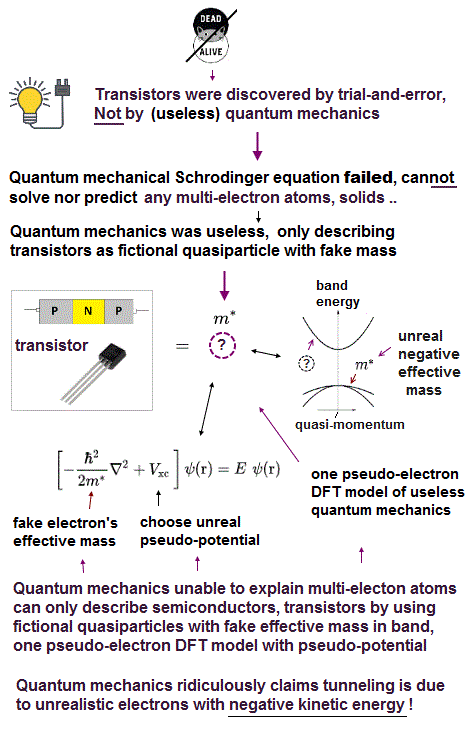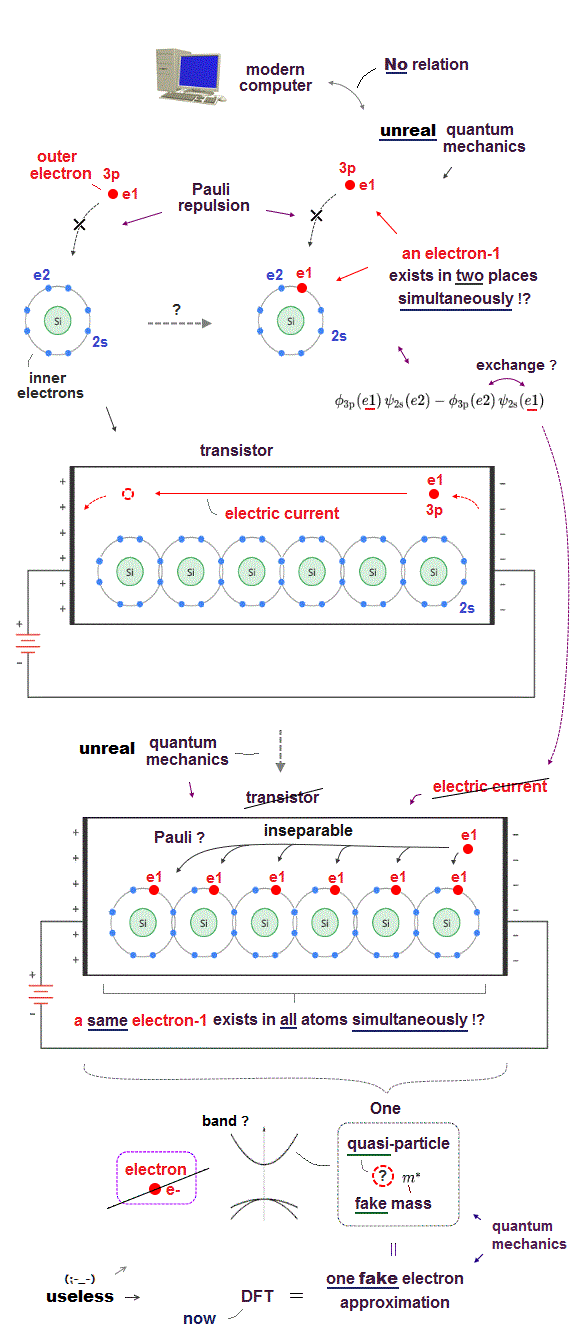
(Fig.1) Quantum mechanics just describing semiconductor as fictional quasiparticle model in band theory was useless for transistors.

"Computer transistors wouldn't have been invented without quantum mechanics ?" is a total lie.
In fact, unphysical quantum mechanics contributed nothing to any useful inventions.
Because quantum mechanical Schrödinger equations for any multi-electron atoms are unsolvable, useless, unable to predict any physical phenomena including solids, semiconductor and transistor ( this p.1-2nd-paragraph, this p.14, this p.2~p.3-upper, this 2nd-paragraph ).
Quantum mechanics has to rely on very rough useless approximation treating the whole material and semiconductor as one pseudo-electron or fictional quasiparticle model ( this p.2-1.1 ) with fake effective mass ( this p.2-upper, this p.5 ) and artificially-chosen effective pseudo-potential ( this p.4-last-paragraph ) in unphysical band theory ( this p.2~p.5 ) including fictitious quasi-momentum ( this p.4-last ).
This-p.3-2nd-paragraph says
"it normally
involves a large number of atoms, molecules and electrons, therefore the resulting full scale
quantum system is intractable. Appropriate approximations (= relying on pseudo-models ) are required"
Transistors were invented through trial-and-error approach and accidental serendipitous discovery, Not through the (useless) quantum mechanical prediction.
This 4th-paragraph says
"Bardeen suggested they replace the silicon with germanium. They got a current jump.. -- but in the exact opposite direction they'd expected ( this-p.2-middle-1st-paragraph )" ← No quantum mechanical prediction
This-lower-Trial and Error says
"the foundations of transistor electronics were created by making errors and following hunches that failed to give what was expected"
This p.16-1st-paragraph says
"there still is No really adequate quantitative
theory explaining the working of the point contact transistor... who observed something that
they were not looking for or expecting (= No quantum mechanical prediction )."
One of transistor inventors, Shockley said in this lecture ↓
p.14-2nd-paragraph says "they are Not yet adequately explained quantitatively. The discrepancy between simple theory and experiment.. is, from deviations from the single (fictitious) effective-mass model of semiconductors"
p.15-1st-paragraph says "It was difficult at the time to interpret these procedures from an atomic point of view and this is still true at present (= quantum mechanical atomic theory is useless )."
This another Shockley paper ↓
p.11-last says "The effective mass concept.. may Not necessary be correct."
p.20-2~3rd paragraphs says "exact theory.. has Not been developed.... phonon (= fictional quasiparticle )"
"two constants were arbitrary chosen to fit (= No quantum mechanical prediction).. effective electron mass.. "
(Fig.2) Applying small current to base induces large current in transistor that does Not need the unphysical quantum mechanical model lacking real electrons.

The mechanism of transistors is simple.
As shown in the upper figure, when small current is applied to the base part (= switch ), larger electric current starts to flow from collector to emitter. That's all.
Researchers discovered the semiconductor suitable for this transistor switch (= whose electric current or resistance drastically changes depending on base small current ) by trial-and-error approach without the (useless) quantum mechanics lacking real particle picture.
Quantum mechanics tries to describe this phenomena by fictional quasiparticle with fake effective mass in unphysical band model, which is useless, unable to predict any transistor's phenomena due to unsolvable Schrodinger equation.
This unphysical quantum mechanics just shows several abstract band energy lines lacking real particle picture, which may be slightly changed by applying current to base part, which fictitious band model can Not tell us any detailed atomic mechanism ( this p.27-Fig.12, this Figure 5.2.2, this middle, this p.26(p.10) ).
Actually, the transistor and semiconductor atomic model uses classical (= realistic ) electrons (= real moving particles ) and holes moved by applied voltage (= compatible with Bohr's realistic atomic moving electrons ) instead of unphysical quantum mechanical (static) wavefunction or electron cloud that cannot move at all.
Quantum mechanics was also useless for discovering tunnelling (= quantum mechanical ridiculous explanation using unreal negative kinetic energy was useless, irrelevant to actual tunnel current ) and MRI.

Feel free to link to this site.